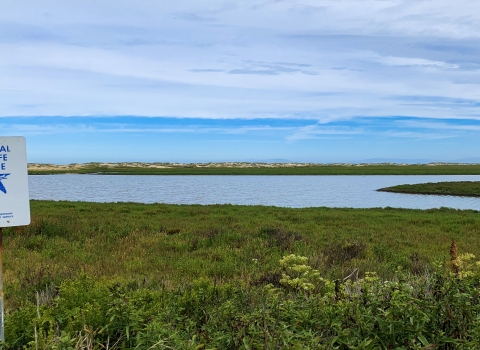Outdoor enthusiasts will find a gem tucked away in southwest Louisiana.
Lacassine National Wildlife Refuge offers everyone opportunities to explore diverse ecosystems, see unique wildlife and take part in several dynamic outdoor activities, like hunting, fishing, boating birding, hiking and outdoor photography.
Established in 1937, Lacassine provides a sanctuary for migratory birds, particularly wintering waterfowl. Depending on the season, visitors may see white-fronted and snow geese or puddle ducks, such as pintails, blue and green-winged teals, mallards, gadwalls, shovelers and American widgeons.
For anglers, the refuge’s waterways offer coveted fishing spots. Popular species include largemouth bass, crappie, sunfish, catfish, bowfin and gar.
"This is an amazing place, a huge public-use facility. People can come here year-round,” said Chuck Talbert, a wildlife officer with the U.S. Fish and Wildlife Service. “It’s a resource for the public, especially those who don't have a lot of land. Here, you can take part in many outdoor activities. That's why it's called a 'sportsman's paradise.'”
Lacassine encompasses nearly 36,000 acres. The landscape is divided: 16,500 acres of freshwater marsh and open water; 16,500 acres of managed, freshwater marsh; 2,200 acres of rice, wheat, soybean and fields; 350 acres of flooded gum and cypress trees; and 350 acres of restored tallgrass prairie.
“We are connected to this land, and we are connected to the community,” said Shaun Ziegler, project leader for the Southwest Louisiana National Wildlife Refuge Complex which includes Lacassine.
Located not far from Lake Charles, Baton Rouge, New Orleans and Texas, Lacassine offers diverse vegetation which provides habitats for wildlife. Species that call the refuge home, include ducks, geese, bobcats, coyotes, foxes, minks, white-tailed deer and alligators. While boating through parts of the refuge, guests may see something unusual too: orphaned wells.
Wells are “orphaned” if they’re not running and nobody’s maintaining them. Getting rid of the derelict structures, abandoned by drilling companies before the lands were acquired by the Service, is a priority for the Service and state partners.
Not only are the abandoned wells eyesores, but the equipment is rusting from years of neglect and, sometimes, debris falls into the water. Some of the wells emit harmful gasses into the atmosphere. Others may not be currently leaking but could in the future.
“The legacy pollution caused by these abandoned wells is concerning,” said Jimmy Laurent, regional energy coordinator for the Service in the Southeast Region. “We are working closely with the Louisiana Department of Natural Resources to leverage the resources we have to eradicate them before they contaminate the landscape, the water and the wildlife.”
The cost per well could exceed $400,000. Laurent says abandoned wells, which on Lacassine are reached only by boat, and dilapidated, disintegrating wooden platforms drive costs. And well depths, anywhere from 2,700 to more than 18,000 feet, also affect the cost.
Approximately 100,000 people visit Lacassine each year. The staff want to make their experiences as enriching as possible. To that end, they are committed to getting rid of abandoned wells.
“One of my goals before I retire is to get rid of the orphan wells that are a major hazard in our waterways,” said Shane Baxter, the Lacassine refuge manager.
Thanks to the Bipartisan Infrastructure Law, funds are being invested in seven refuges across Louisiana. The Service will spend more than $14.3 million to plug 164 orphaned wells on seven national wildlife refuges in Louisiana.
Mediation has already started on Lacassine, Black Bayou Lake, and D’Arbonne refuges. Red River, Tensas, Atchafalaya, and Upper Ouachita refuges, all in Louisiana, will also benefit. On Lacassine, Bipartisan Infrastructure Law Bipartisan Infrastructure Law
The Bipartisan Infrastructure Law (BIL) is a once-in-a-generation investment in the nation’s infrastructure and economic competitiveness. We were directly appropriated $455 million over five years in BIL funds for programs related to the President’s America the Beautiful initiative.
Learn more about Bipartisan Infrastructure Law dollars will be used to plug and remove 11 wells and restore the landscape to its original condition.
Before the Bipartisan Infrastructure Law was enacted, the Service relied on the state’s oil and gas commission to plug orphaned wells.
“This is definitely a multi-agency effort,” Laurent said. “We are now working closely with the Louisiana Department of Natural Resources and have coordinated with the Bureau of Land Management, National Park Service and the Forest Service. This collaboration gives us a better picture of orphaned wells and allows for consistency across all federal lands.”
Representatives from the Louisiana DNR say the advantages of the partnership with the Service extend beyond cleaning up the wells.
“These projects create jobs that strengthen local economies and the longstanding relationship between the Service and the state,” said Patrick Courreges, communication director for Louisiana DNR.



